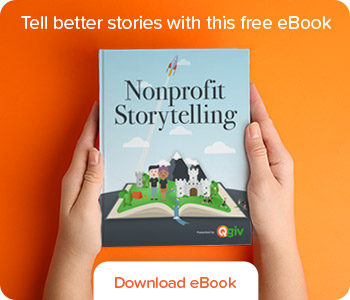Everyone loves a good story—your donors included! A well-told story will connect your donors to your mission, inspire them to give, and keep them engaged in the future. Tell the best-possible stories with these tips from Rachel Muir, CFRE, who helps nonprofit fundraisers all around the country find and create unique stories.
- Remember that fundraising is all about empathy
- Don’t be afraid to get emotional
- Catch donors’ attention with a provocative opening
- Write at a sixth-grade reading level
- The elements of a good story
- The dos and don’ts of nonprofit storytelling
- Use multimedia
- Make it actionable
Storytelling Tip: Remember that fundraising is all about empathy
People give to other people, not to organizations or causes. That may feel like a blow to your ego (don’t worry! Your nonprofit is doing necessary work), but it’s actually great news. Trying to build an emotional connection between a donor and a nonprofit organization is hard. Building an emotional connection between a donor and another person is way easier.
Helping your donors empathize with the people who benefit from your programming is a powerful way to inspire them to donate. When you tell your stories, use language that helps your donors put themselves in your clients’ shoes. Talk about your clients’ emotions, their struggles and successes, and how donors can help others just like them.
Storytelling Tip: Don’t be afraid to get emotional
During her presentation, Rachel shared a great quote from Jeff Brooks. “Like it or not, great fundraising is bursting with emotion,” he said. “Using emotion in your fundraising is no more unethical than using oxygen to breathe.”
If you’re worried about using emotions in your fundraising, don’t be! Humans are emotional creatures. We want to feel things. That’s why we read inspiring books, watch sad movies, and are suckers for a feel-good YouTube video. A donor’s decision to give is an emotional one. Appeal to those emotions if you want them to donate!
Storytelling Tip: Catch donors’ attention with a provocative opening
There’s a time and a place for a slow burn, but nonprofit stories aren’t it. You’re competing for your donors’ attention, and a provocative opening is the best way to win. Use an attention-grabbing opening sentence or paragraph that will intrigue donors enough that they’ll continue reading. Ask a hard question, introduce a sympathetic character, jump into the middle of a story, include an evocative photo—whatever you decide to do, make sure it’s compelling enough that donors automatically keep reading.
Brother Wolf Animal Rescue is a nonprofit that excels at telling compelling stories. Check out this blog post for storytelling tips from one of their best appeals.
Storytelling Tip: Write at a sixth-grade reading level
Leave your long words and complex sentence structures at the door! The best way to ensure your donors read and absorb your stories is to use simple language. Writing at a sixth-grade reading level will help you connect with and inspire your donors.
This is because using simple language helps your donors connect with the characters and emotions in the story. When donors spend less brainpower processing the words you use to tell your stories, they have more brainpower to devote to identifying with the people and circumstances you describe. Don’t try to impress your high school English teacher with your stories! Keep it simple and focus on the content rather than your syntax. You’ll be much more effective!
Storytelling Tip: Write with the elements of a good story in mind
When it comes to telling a good story there are certain elements that you must have to be successful. As you tell your story, keep these five elements in mind: the premise, the plot, the characters, the prose, and the theme. These five elements will empower you to tell a great story.
First and foremost, you need to identify your premise before you start writing. Your premise establishes the setting, characters, and circumstances around the story.
Next, identify your plot. The plot is made up of the events that move the story forward. Your conflict and resolution to your story are part of the story’s plot.
Third, you’ll need characters to tell your story well. For nonprofits, it can be the story of someone who benefitted from the important work your nonprofit does. Or it could be the story of how someone in your nonprofit delivers those services. You’ll want to make sure that the character you choose is compelling and is conducive to the telling of a good story.
Fourth is prose. Prose determines how the story is written. Make sure you’re writing in your nonprofit’s voice and that the tone is effective for the purpose of the story. Prose also determines the point of view the story is written in. Is it going to be in first person? Third?
Last is the theme. The theme of your story should encourage your reader to take action. When they read the story, they should be compelled to act because they recognize the theme of the story as one of helpfulness. If you write a compelling story with a solid theme your readers will be more likely to do what you ask of them.
Storytelling Tip: Obey the dos and don’ts of nonprofit storytelling
When it comes to nonprofit storytelling there are definitely some must-dos and do nots that should be adhered to.
Dos
First, make your stories meaningful to everyone. When you write your story, you should keep in mind how your audience will respond to it. You want them to take action, so your story should be meaningful to whoever reads it so that they’ll be inspired to do something to support your cause.
Another must-do is to be authentic. Authenticity is key when it comes to nonprofit storytelling. Be honest and transparent about your successes and challenges and share stories that are true to your organization’s mission and values.
Don’ts
You want to make sure you’re writing from a consistent point of view, so don’t switch your point of view during your story. Your narrator should remain the same throughout your story to cut down on confusion. It also helps to write in the same tense consistently throughout.
Another consideration you must make is your use of characters. You don’t want them to come off as flat and boring. Build interest in your characters instead. Make it clear what motivates them, bring them to life, and make sure that they are inspiring for your audience.
For more on telling effective stories at your nonprofit, check out our comprehensive guide to nonprofit storytelling.
Storytelling Tip: Use Multimedia
Incorporating multimedia into your nonprofit storytelling can help to engage your audience and bring your story to life. Consider using photos, videos, and other visual elements to help illustrate your message.
Storytelling Tip: Make it Actionable
Finally, make sure your nonprofit storytelling is actionable. Include a call to action that encourages your audience to get involved with your organization, whether it’s by making a donation, volunteering, or spreading the word about your work.
Watch Rachel’s webinar for more storytelling tips (and tons of examples)
Rachel’s complete webinar, Storytelling for Better Fundraising, is available to view on demand! Grab a pen and paper, settle in, and learn even more great ways to share your stories. Her session also includes examples of great nonprofit stories that will inspire you.
Looking for more resources?
Download Qgiv’s Nonprofit Storytelling eBook for tons of tips and examples on telling your organization’s story.








